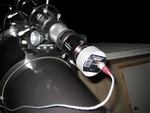Imaging Equipment - Guiders
So far I have used three autoguider cameras. The first is Meade DSI color, which was initially my first real imaging camera. As a guider, it worked well with PHD program, except some occasional driver glitches, preventing at some point using exposures longer than 1 second. The sensitivity of this camera is OK, however the size of the chip is on the small size. Probably a Pro version, which is monochromatic would be have been more sensitive.
 The second
guider camera I got was Orion StarShoot Autoguider. It is a mono camera
with 1280x1024 5.2 micron pixels in a 4/3" CMOS sensor. It is more
sensitive than Meade DSI, and its sensor is bigger. The pixels are
smaller, which works better when guiding via small refractors. It is a
bit noisy, compared to other modern cameras, which is a problem when
using faint guide stars. It is very good value for the money! The
nosepiece unscrews easily and the unit can be mounted on any T-thread
connector. It works very well with PHD guiding.
The second
guider camera I got was Orion StarShoot Autoguider. It is a mono camera
with 1280x1024 5.2 micron pixels in a 4/3" CMOS sensor. It is more
sensitive than Meade DSI, and its sensor is bigger. The pixels are
smaller, which works better when guiding via small refractors. It is a
bit noisy, compared to other modern cameras, which is a problem when
using faint guide stars. It is very good value for the money! The
nosepiece unscrews easily and the unit can be mounted on any T-thread
connector. It works very well with PHD guiding.
My third guider is StarlightXpress Lodestar. It is very sensitive and especially well suited to work in off-axis guiders and adaptive optics systems. It has a monochromatic ICX429AL Sony Exview CCD with 752x580 8.2x8.4 micron pixels (6.4x4.75mm). The entire body has 1.25" barrel diameter making it very easy to use it in any 1.25" eyepiece adapter. It works very well with PHD guiding.
The fourth camera used a guider is Imaging Source DMK 21AU04, mono guiding camera that can also be used as a planetary camera.